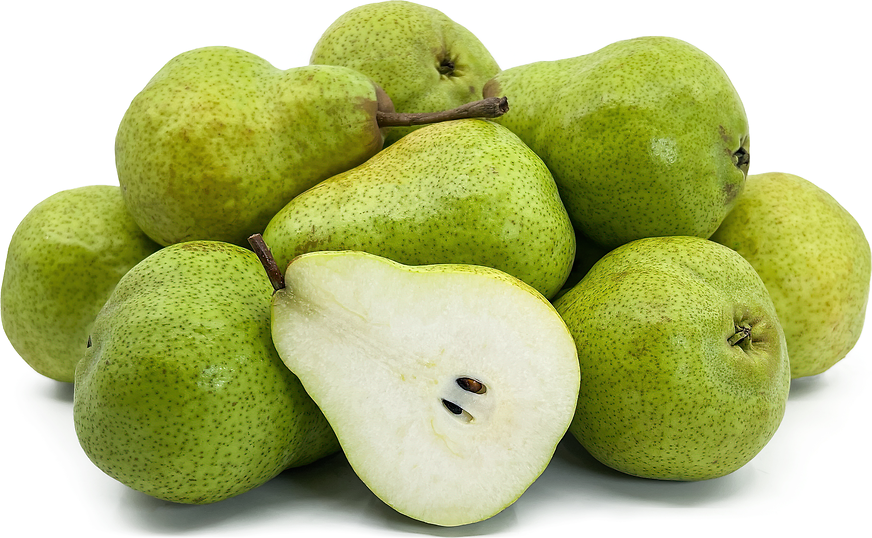


Packham Pears
Estimated Inventory, 40 lbs : 0
Description/Taste
Packham pears are medium to large in size, with an irregular shape featuring a bulbous, wide bottom that tapers to a smaller, rounded neck. They are topped with a slender, dark brown stem. These pears have a vibrant green skin that gradually fades to a light green-yellow. This thin skin is covered in patches of russeting, prominent lenticels, and small, smooth bumps. The flesh has an ivory hue and a smooth, fine-grained texture encasing a central core with a few, black-brown seeds. This flesh starts out hard but ripens to a more moist, soft, and slippery consistency. When ripe, Packham pears are rich, juicy, and creamy with a sweet, aromatic flavor and mildly musky notes.
Seasons/Availability
Packham pears may be available from late spring to early winter, with a peak season in autumn.
Current Facts
Packham pears are botanically classified as Pyrus communis and belong to the Rosaceae family along with apricots, apples, cherries, nectarines, peaches, and plums. They are an Australian hybrid variety that’s also referred to as Packham’s Triumph. Packham pears are a cross between Uvedale’s St. Germain and Williams’ Bon Chrétien pears. This cultivar was developed in the late 1800s and is thus considered an heirloom. Packham pears are the most popular type of pear in Australia and the most exported. Other popular varieties from this country include Williams, Beurré Bosc, Red Anjou, Winter Nelis, Joséphine de Malines, and Red Sensation. Packham pears were named after their inventor Charles Packham and were created with the intention of developing a late-ripening variety with a long harvesting season. They are used primarily for their culinary properties, known for having a sweet flavor and smooth consistency.
Nutritional Value
The nutritional value of the Packham variety isn’t widely known but pears in general are particularly rich in folate, which supports cell growth and development, and vitamin C, a powerful antioxidant that boosts the immune system and promotes healthy skin. They also provide vitamin K, which is crucial for blood clotting and bone health, as well as copper, aiding in iron absorption and helping maintain nerve and immune system function. High in dietary fiber, pears support digestive health and help regulate blood sugar levels. They are also an excellent source of potassium, which is vital for heart function, muscle contraction, and maintaining healthy blood pressure. Pears contain polyphenol antioxidants, which help reduce inflammation and may protect against chronic diseases.
Applications
Packham pears are best suited for both raw and cooked applications such as baking or poaching. They can be served fresh, out-of-hand as a snack, sliced and mixed into leafy green salads, tossed in fruit or pasta salad, layered on cheese boards with nuts and other fruit, blended into smoothies, or sliced over vanilla ice cream. They can also be poached in red wine, poached in butter, brown sugar, and cinnamon, or drizzled with honey and baked until caramelized. Packham pears compliment arugula, kale, cheeses such as brie, blue, gorgonzola, or parmesan, pork, walnuts, pine nuts, grapes, and white balsamic vinegar. They will keep 3-8 days when stored at room temperature and will keep for several weeks when stored in the refrigerator.
Ethnic/Cultural Info
Packham pears were developed in Molong, a city in New South Wales. Today the town has fallen out of cultivating pears in orchards as a source of income, but the townspeople are still proud of their pear’s global notoriety and have developed several events to continue the celebration and awareness of this sweet fruit. The Molong Historical Society has organized cooking fundraisers and heritage weekends to promote Packham pears and attract tourists to the town, giving them the opportunity to learn about this unique variety.
Geography/History
Packham pears were originally developed in Molong, a city in New South Wales, Australia in 1896 by Charles Packham. Pears were first introduced to Australia by the First Fleet and are now grown in provinces with temperate climates. The Packham variety gained popularity in Australia after winning first prizes at the New South Wales Agricultural Society’s Sydney show and was cultivated by Sir William MacArthur at Camden Park in New South Wales from 1820 to 1861. Today Packham pears are primarily grown in countries within the southern hemisphere including Australia, Chile, Argentina, and South Africa, and are shipped globally. They can also be found in home gardens and at select farmers' markets in the United States.
Recipe Ideas
Recipes that include Packham Pears. One
| Cook Almost Anything |
|
Hibiscus Tea Poached Packham Pears |
| SBS Australia |
|
Packham Pear, Parsnip and Potato Soup with Walnuts |
| Cooking on the Front Burner |
|
Easy Pear & Sweet Potato Soup |
Podcasts

















